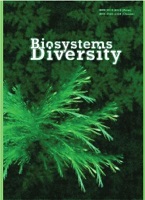Effect of antigibberellins on morphogenesis, photosynthetic apparatus, productivity and their residual content in tomato fruits
Effect of antigibberellins on morphogenesis, photosynthetic apparatus, productivity and their residual content in tomato fruits
Author(s): V. V. Rohach, V. G. Kuryata, D. A. Kiriziy, S. K. Sytnyk, I. H. Grabyk, O. V. Kaitanyuk, M. V. Tarasyuk, T. I. RohachSubject(s): Agriculture, Energy and Environmental Studies, Environmental interactions
Published by: Дніпропетровський національний університет імені Олеся Гончара
Keywords: Lycopersicon esculentum Mill.; retardants; morphometry; leaf apparatus; leaf mesostructure; cenotic indices; photosynthesis; yield; retardants’ residual quantities;
Summary/Abstract: ding tasks of modern plant physiology. Retardants – gibberellin inhibitors are widely used for this purpose. We investigated the effect of foliartreatment with EW-250, ССС-750 and 2-СEPA on morphogenesis, leaf apparatus, content of photosynthetic pigments, indices of chlorophyll fluorescence induction, CO2 gas exchange, and residual amounts of drugs in the fruits of tomato (Lycopersicon esculentum Mill.) Bobcat hybrid. The field experiment was laid on plots with an area of 33 m2 . The treatment of the plants was carried out at the budding stage. Morphometric indices were determined at the stages of flowering and fruit formation. The chlorophylls content was determined in the raw material by the spectrophotometric method. Indices of photosystem II (PSII) photochemical activity were determined according to the parameters of chlorophyll fluorescence induction after a halfhour exposure of plants in the dark using a portable single-beam fluorimeter "Floratest". The determination of the residual content of retardants in the fruits was carried out on a Shimadzu GC gas chromatograph with a mass spectrometric detector – GCMS- QP2020 EI. All gibberellin inhibitors reduced linear plant size. The number of leaves on the plants decreased under 2- CEPA treatment, and increased after the application of EW-250. Treatment with 2-CEPA decreased, EW-250 significantly increased, and CCC-750 practically did not change the leaves’ fresh and dry weight. Leaf area and leaf index decreased under 2- CEPA treatment, but practically did not change when EW-250 and ССС-750 were applied. All antigibberellin drugs increased the leaf specific leaf weight and thickened the leaf lamina due to the growth of chlorenchyma cells. At the same time, growth inhibitors increased the volume of columnar parenchyma cells and practically did not change the size of spongy parenchyma cells. Retardants increased the chlorophylls content in leaves, while the ethylene producer 2-CEPA did not change this index. The plants’ chlorophyll index after treatment with drugs increased significantly. The whole plant dry weight increased under EW-250 treatment, decreased after 2-CEPA application, and did not change under CCC-750. It was established that the photosynthetic rate increased under the EW-250 treatment, both in the flowering stage and in the stage of fruit formation, while when using 2-CEPA and CCC-750, it occurred only at the stage of fruit formation. The most significant positive changes of PSII photochemical activity indices were observed under the use of EW-250. Under the action of the drug, the maximum and actual quantum efficiency of PSII increased, the linear electron transport accelerated, and the fraction of reaction centers that did not transfer electrons from the primary acceptor QA to QB decreased, at the same time the chlorophyll fluorescence decay coefficient significantly increased, which indicates an increase in the CO2 assimilation intensity.Retardants increased the proportion of the fruit in the whole plant dry weight. All growth regulators increased net photosynthetic efficiency. A significant increase in fruit yield occurred under EW-250 treatment. When using CCC-750, the index tended to increase, while under the influence of 2-CEPA the yield decreased. The residual amounts of EW-250 and CCC-750 in the fruits did not exceed the maximum permissible concentrations.
Journal: Biosystems Diversity
- Issue Year: 31/2023
- Issue No: 2
- Page Range: 191-201
- Page Count: 11
- Language: English

